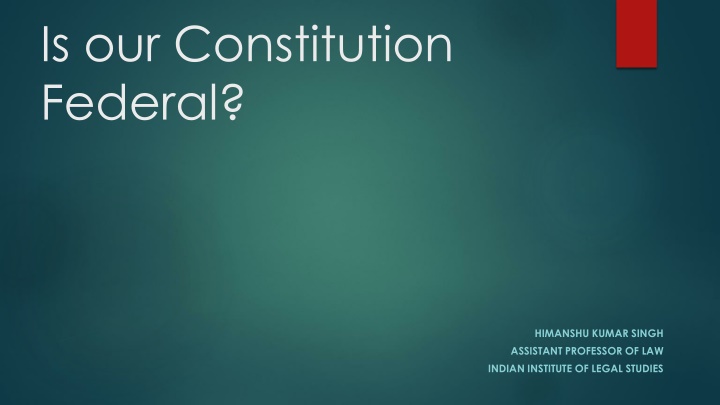The Federal Features of the Indian Constitution
The Indian Constitution exhibits a unique blend of federal and unitary characteristics, termed as quasi-federal. This constitutional setup grants power to both the center and states, yet allows for central intervention in certain circumstances. The Parliament holds authority over creating new states, altering boundaries, and enacting laws in the national interest, while also outlining emergency provisions. The judiciary has recognized this dual nature of the Indian Constitution, acknowledging its quasi-federal design with features of both unitary and federal systems.
Download Presentation

Please find below an Image/Link to download the presentation.
The content on the website is provided AS IS for your information and personal use only. It may not be sold, licensed, or shared on other websites without obtaining consent from the author.If you encounter any issues during the download, it is possible that the publisher has removed the file from their server.
You are allowed to download the files provided on this website for personal or commercial use, subject to the condition that they are used lawfully. All files are the property of their respective owners.
The content on the website is provided AS IS for your information and personal use only. It may not be sold, licensed, or shared on other websites without obtaining consent from the author.
E N D
Presentation Transcript
Is our Constitution Federal? HIMANSHU KUMAR SINGH ASSISTANT PROFESSOR OF LAW INDIAN INSTITUTE OF LEGAL STUDIES
Unitary or Federal? APPOINTMENT OF GOVERNORS The Governors of the States are appointed by the President (Articles 155 and 156) and is answerable to him. However, the Governor acts on the aid and advise of the Council of Ministers. PARLIAMENT S POWER TO LEGISLATE IN THE NATIONAL INTEREST Under Article 249 of the Constitution, the Parliament is authorized to make laws on all subjects mentioned in the State List if the Rajya Sabha passes a resolution by 2/3rdmajority that it is necessary in the national interest. Doctrine of Repugnancy: In accordance to Article 254, states that if any part of State law is repugnant or conflicting to any part of a Central law which the Parliament is competent to enact, or to any part of a law of the matter of List III, then the Central law made by the Parliament shall prevail and the law made by the State legislature shall become void, to the extent of its repugnancy
PARLIAMENTS POWER TO MAKE NEW STATES & ALTER BOUNDARIES OF EXISTING STATES Under Article 3 of the Constitution, the Parliament may form new states; it may increase or diminish the boundary of existing state and it may alter the names of any state. EMERGENCY PROVISIONS Constitution envisages 3 types of emergency: (i) War, External Aggression or Armed rebellion (Art 352), (ii) failure of Constitutional machinery (Art 356) and (iii) Financial Emergency (Art 360). BICAMERAL LEGISLATURE The main feature which is in the definition itself that there are at least two levels of governance in the country but there is a possibility that there could be more than two levels of governance and the entire power is not in the hands of one government. CITIZENSHIP Like Canada India has also introduced single citizenship but there are no separate citizenships for states. Whoever are the citizens of India enjoy the same right and could exercise it irrespective of the part of the country they belong or their place of birth or the place of residence.
Answer Prof. Wheare observes, India s form of governance as quasi-federal in nature, or unitray with federal features or federal with unitary features. Jennings has characterized the Indian Constitution as a federation with strong centralizing tendency. Supreme Court, in State of West Bengal v Union of India (1963) held that, in certain circumstances the Constitution is federal as it empowers the centre to interfere in the state matters and thus places the states in a subordinate position which violates the federal principle. Hence, the Supreme Court too, held that the nature of the India Constitution is quasi federal having features of both unitary and federal constitutions.

